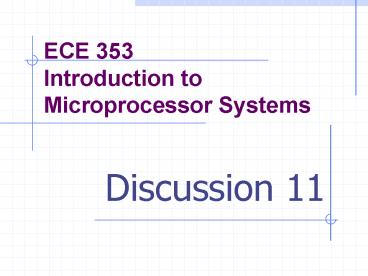ECE 353 Introduction to Microprocessor Systems PowerPoint PPT Presentation
1 / 18
Title: ECE 353 Introduction to Microprocessor Systems
1
ECE 353Introduction to Microprocessor Systems
Discussion 11
2
Topics
- Interrupts and Exceptions
- QA
3
Interrupts and Exceptions
- The ADuC7026 has eight types of exceptions. Table
2-3 - The ADuC7026 defines locations for each exception
vector the code must put the proper
instructions there to handle each exception.
Table 2-4 - ADuc7026.s places the address of the IRQ handler
in the proper vector location. - Exception.s contains the actual exception handler
routines. - The interrupt checklist posted on the course web
page gives guidelines of what needs to be done to
correctly handle interrupts. - The ADuC7026 has 23 sources of interrupts. Table
72
4
Interrupt Problem
- Assume that the CPU is being clocked at 41.78MHz
(32768Hz x 1275). Set up timer 1 to generate a
periodic interrupt at a frequency of 3.2kHz.
Produce an output on pin 4.0 that will have a
duty cycle given by duty/32, where duty is a byte
memory variable. The ISR can only make one change
to the P4.0 state in each invocation. Only use
the five least significant bits of duty.
5
Answer
- Requirements
- Timer setup to give a 3.2 kHz periodic
interrupt - Timer ISR use to handle generating the proper
output - Variables Count (for timer period tracking) and
Duty (for setting the duty cycle) - Output pin P4.0
6
Answer
- In Main, we need
- Setup GPIO for P4.0
- Setup Timer1
- Initialize variables
- Setup ISR
- In ISR, we need
- Update count
- Update output
7
Answer
- Variables
- Count to get duty cycle increments of 1/32, we
need to keep track of Timer ISR occurrences
Count will need values of 0-31. - Each execution of the Timer ISR will need to
increment or decrement Count, and if it reaches
the limit, reload the start count. - Duty Duty will be set in main will determine
how many of the 32 occurrences of the Timer ISR
in one period will need to set the output high.
(Timer ISR will not modify this variable.)
8
Answer
- Timer1 config
- System clock at 41.7792 MHz means clock period of
23.935 ns. - Timer frequency of 3.2 kHz means timer period of
312.5 us. - Using divide by one, we need a T1LD value of
312.5 us/23.935 ns 13056 - Also need to configure Timer1 to be periodic,
enabled, binary, down - Another way to look at Timer1s configuration
- System clock at 41.7792 MHz
- Timer frequency of 3.2 kHz
- Using divide by one, 41.7792 MHz / 3.2 kHz / 1
13056 T1LD - GPIO config
- Set GPIO P4.0 as GPIO, output
- Initialize P4.0 to zero
- ISR config
- Enable Timer 1 IRQ
9
Answer
- ISR details
- Get Count and Duty variables
- Test if Count lt Duty, then P4.0 1, else P4.0
0 - Count Count - 1If (Count lt 0) Count 31
- Store updated Count
10
ConcepTest
- What is the frequency of the output waveform?
- 3.2 kHz / 32 100 Hz
- What is the minimum average value?
- 0
- What is the maximum average value?
- 31/32 0.96875
- To achieve 1.0, we would need to relax the
restriction on the bits of Duty to allow using
6-bits so we could go 0 32.
11
Answer
- Code Main.s
- Filename main11.s
- Author ECE 353 Staff
- Description main program file for discussion
11 - ARM use ARM instruction set
- EXPORT __main
- EXPORT Count
- EXPORT Duty
- INCLUDE aduc7026.inc
- count down, periodic, binary, source/1
- T1CON_VALUE EQU 0x000000C0
- need interrupt at 3.2 kHz with 41.7792 MHz clock
- T1_PERIOD EQU 13056
- timer1 interrupt
- TMR1_IRQ_EN EQU 0x00000008
12
Answer
- Code Main.s (cont.)
- AREA FLASH, CODE, READONLY
- __main
- setup GPIO pin 4.0 as output, initially zero
- LDR R7, (GPIO_MMR_BASE) MMR base address
- MOV R0, 0x00
- LDR R1, R7, GP4CON get P4 as GPIO
- BIC R1, R1, 3
- STR R1, R7, GP4CON set P4.0 as GPIO
- LDR R1, R7, GP4DAT get P4 as GPIO
- ORR R1, R1, 0x01000000 set P4.0 as output
- BIC R1, R1, 0x00010000 set P4.0 as zero
- STR R1, R7, GP4DAT
- intitialize variables
- LDR R7, (Count) count address
- MOV R0, 31
- STRB R0, R7 store initial count value
13
Answer
- Code Main.s (cont.)
- setup timer1
- LDR R7, (TIMER_MMR_BASE) register base
- LDR R0, (T1_PERIOD)
- STR R0, R7, T1LD set timer period
- LDR R0, (T1CON_VALUE)
- STR R0, R7, T1CON configure timer
- setup interrupt
- LDR R7, (IRQCON_MMR_BASE) register base
- MOV R0, TMR1_IRQ_EN
- STR R0, R7, IRQEN enable timer1 interrupt
- spin
- B spin
- END
14
Answer
- Code Exception.s
- IMPORT Duty
- IMPORT Count
- ...
- IRQ_Handler
- PUSH R0-R4 context save
- LDR R2, (Duty)
- LDRB R0, R2 get current duty cycle
- AND R0, R0, 0x1F use only 5 least significant
bits - LDR R2, (Count)
- LDRB R1, R2 get current count
- LDR R3, (GPIO_MMR_BASE)
- CMP R1, R0 Count less than Duty - put out
one - MOV R4, 0x00010000 1 in bit 16
- STRHS R4, R3, GP4CLR set P4.0 to zero
- STRLO R4, R3, GP4SET set P4.0 to one
- SUBS R1, R1, 1 decrement, set flags
15
Questions?
16
(No Transcript)
17
(No Transcript)
18
(No Transcript)

